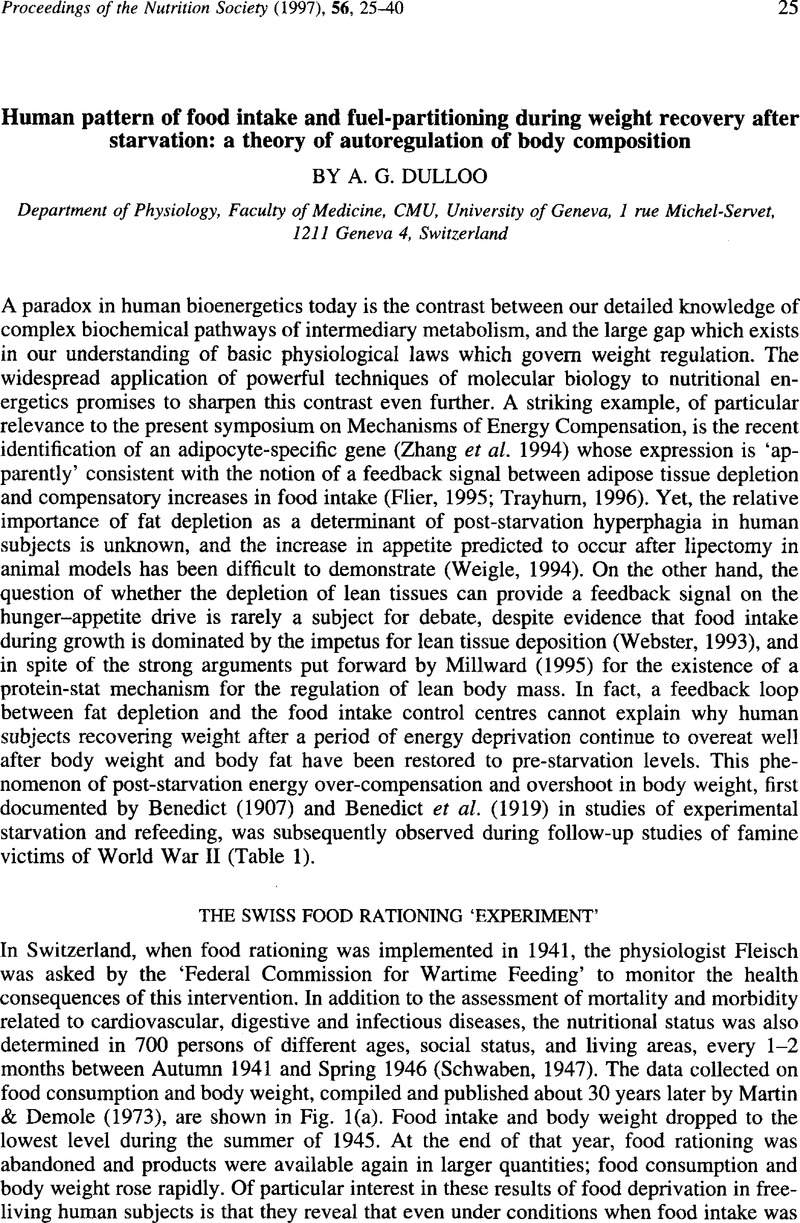Crossref Citations
This article has been cited by the following publications. This list is generated based on data provided by Crossref.
Dulloo, Abdul G
and
Jacquet, Jean
1998.
Adaptive reduction in basal metabolic rate in response to food deprivation in humans: a role for feedback signals from fat stores.
The American Journal of Clinical Nutrition,
Vol. 68,
Issue. 3,
p.
599.
Melchior, Jean-Claude
1998.
From malnutrition to refeeding during anorexia nervosa.
Current Opinion in Clinical Nutrition and Metabolic Care,
Vol. 1,
Issue. 6,
p.
481.
Millward, D. Joe
and
Wijesinghe, D. G. N. G.
1998.
Energy partitioning and the regulation of body weight – Reply by Millward & Wijesinghe.
British Journal of Nutrition,
Vol. 79,
Issue. 1,
p.
111.
Dulloo, A. G.
1998.
Partitioning between protein and fat during starvation and refeeding: is the assumption of intraindividual constancy of P-ratio valid?.
British Journal of Nutrition,
Vol. 79,
Issue. 1,
p.
107.
Dulloo, A. G.
and
Jacquet, J.
1999.
The control of partitioning between protein and fat during human starvation: its internal determinants and biological significance.
British Journal of Nutrition,
Vol. 82,
Issue. 5,
p.
339.
James Stubbs, R
and
O’Reilly, Leona
1999.
Neural and Metabolic Control of Macronutrient Intake.
Troyer, Dean A.
and
Fernandes, Gabriel
2000.
Nutrition and Immunology.
p.
35.
2001.
Abstracts of Original Communications.
Proceedings of the Nutrition Society,
Vol. 60,
Issue. 4a,
p.
1A.
Speakman, John R.
2004.
Obesity: The Integrated Roles of Environment and Genetics.
The Journal of Nutrition,
Vol. 134,
Issue. 8,
p.
2090S.
de la Maza, María Pía
Agudelo, Gloria Maria
Yudin, Talía
Gattás, Vivian
Barrera, Gladys
Bunout, Daniel
and
Hirsch, Sandra
2004.
Long-Term Nutritional and Digestive Consequences of Pelvic Radiation.
Journal of the American College of Nutrition,
Vol. 23,
Issue. 2,
p.
102.
Frankham, Patrick
Gosselin, Caroline
and
Cabanac, Michel
2005.
Diet induced weight loss accelerates onset of negative alliesthesia in obese women.
BMC Public Health,
Vol. 5,
Issue. 1,
Yeh, Shing-shing
and
Schuster, Michael W
2006.
Megestrol acetate in cachexia and anorexia.
International Journal of Nanomedicine,
Vol. 1,
Issue. 4,
p.
411.
Speakman, John R.
2007.
A Nonadaptive Scenario Explaining the Genetic Predisposition to Obesity: The “Predation Release” Hypothesis.
Cell Metabolism,
Vol. 6,
Issue. 1,
p.
5.
Speakman, John R.
2007.
Appetite and Body Weight.
p.
301.
Cameron, Jameason D.
Goldfield, Gary S.
Cyr, Marie-Josée
and
Doucet, Éric
2008.
The effects of prolonged caloric restriction leading to weight-loss on food hedonics and reinforcement.
Physiology & Behavior,
Vol. 94,
Issue. 3,
p.
474.
Robin, Jean-Patrice
Decrock, Frédéric
Herzberg, Gene
Mioskowski, Eliane
Le Maho, Yvon
Bach, André
and
Groscolas, René
2008.
Restoration of Body Energy Reserves during Refeeding in Rats Is Dependent on Both the Intensity of Energy Restriction and the Metabolic Status at the Onset of Starvation ,2.
The Journal of Nutrition,
Vol. 138,
Issue. 5,
p.
861.
Yeh, S. -S.
Lovitt, S.
and
Schuster, M. W.
2009.
USAGE of megestrol acetate in the treatment of anorexia-cachexia syndrome in the elderly.
The Journal of Nutrition, Health and Aging,
Vol. 13,
Issue. 5,
p.
448.
Dulloo, Abdul G.
Jacquet, Jean
and
Montani, Jean-Pierre
2012.
How dieting makes some fatter: from a perspective of human body composition autoregulation.
Proceedings of the Nutrition Society,
Vol. 71,
Issue. 3,
p.
379.
Dulloo, Abdul G.
Jacquet, Jean
Seydoux, Josiane
and
Montani, Jean-Pierre
2013.
Comment les régimes amaigrissants font grossir : d’une perspective d’autorégulation de la composition corporelle.
Cahiers de Nutrition et de Diététique,
Vol. 48,
Issue. 1,
p.
15.
Dulloo, A. G.
Jacquet, J.
Montani, J.‐P.
and
Schutz, Y.
2015.
How dieting makes the lean fatter: from a perspective of body composition autoregulation through adipostats and proteinstats awaiting discovery.
Obesity Reviews,
Vol. 16,
Issue. S1,
p.
25.





